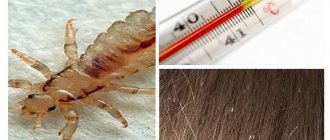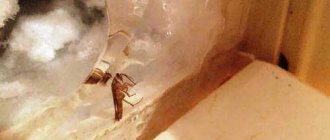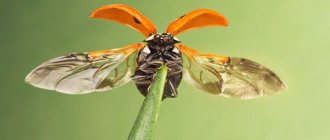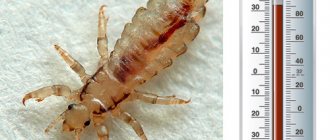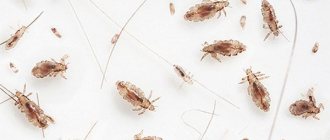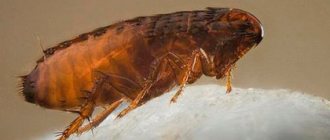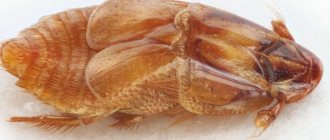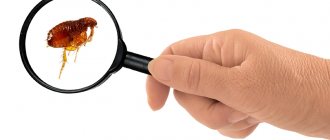When wondering at what temperature house fleas and their larvae die, it is worth noting that parasites are afraid of both cold and heat.
Cat and dog bloodsuckers can exist at +10-35 C°; their period of development and life will depend on the thermometer readings. It is in their home that they feel more comfortable than anywhere else.
It is easier to destroy adults than its eggs. This is explained by the fact that the embryo shell is resistant to various temperature changes. Larvae can die when directly exposed to high temperatures from +45 C° or at low temperatures from -15 C°.
Features of the life of a flea
The insect feeds on the blood of animals and people. And only sexually mature individuals. The larvae eat the feces of adult bloodsuckers and organic particles. Having fed, the parasite leaves its victim and looks for another object. In the absence of food, a flea can live up to 30 days. Insects are carriers of dangerous infections, including helminthic infestations. Imago - adult insects can live in apartments or houses for several months. They remain in the form of a pupa throughout the entire period.
In abandoned premises, parasites do not die; fleas exist without problems, without food. Feeling the vibrations of the floor, the steps of a person or animal, they go hunting. The optimal conditions for the development and life of insects are a suitable temperature - 15-27 degrees and humidity - 75-100%. At what temperature do fleas die ? These parameters are also scary for the larvae. If the temperature drops and the humidity is less than 70%, development stops and they die.
Effect of cold
The influence of cold on ectoparasites
Most often, people suffer from problems with parasites during the warm period of the year. In winter, fleas look for more secluded places, such as basements. But if the bloodsucker does not find a food source there, then it may well become a pet.
When the mercury drops below 15 degrees, bloodsuckers will feel discomfort. Therefore, when answering whether fleas are afraid of the cold, it is correct to say that it is uncomfortable for them. But they will begin to die only at negative levels.
How does heat affect fleas?
Blood-sucking insects are equally afraid of both cold and heat . At what temperature do fleas die - interesting information. So animal fleas and bed parasites begin to die at 47°C. Of course, such a high temperature is unlikely to occur in any apartment or private house, but now insects are destroyed using special thermal units. Bed fleas are removed by boiling linen.
Steam generator against fleas
Modern installation is used in cleaning clothes, upholstery and so on. The generator operates by heating water with a heating element, which is converted into steam. The steam is directed to those places where the largest concentration of parasites, larvae and eggs is found. It is necessary to act for several minutes, waiting for the insects to begin to die. The power of the steam apparatus is important; the greater it is, the greater the effect. Fleas die at temperatures critical for their existence. The room must be treated according to the following rules:
- the temperature should be from +50 degrees;
- start the operation after washing the animals;
- scald all clothes and surfaces in the house;
- Do not direct steam jets at paintwork.
The best steam generators are those used by sanitary services.
Exposure to heat
For blood-sucking parasites, high temperatures are no less dangerous than extreme cold. It has been noticed that as soon as the thermometer rises to +47⁰C, the flea tries to retreat to a more comfortable place.
At temperatures above +53⁰С, the pest ceases to navigate in space and begins to move chaotically. If he remains in such conditions for more than half an hour, he faces certain death. When the threshold reaches +70⁰C, the insect immediately dies.
It is unrealistic to create such conditions naturally, but you can use special equipment - a steam generator. Steaming for fleas is a surefire way to get rid of the parasite. Household devices are designed for cleaning clothes, furniture and interior items. They will be effective if the output is steam heated to a temperature above +50⁰С.
For reference! Sanitary services are armed with industrial equipment aimed specifically at the destruction of blood-sucking pests - bedbugs, lice and fleas. Serious equipment allows you to treat large areas with steam in a matter of minutes.
How to kill flea larvae
Flea larvae are very similar and sometimes it is difficult to determine which type of parasite they belong to. In the fight against them, means are used that are used to exterminate adult fleas, and at what temperature fleas die can be found on the Internet. Some remedies are powerless. For example, wormwood will scare off imagoes faster, but will not affect the larva. There are means to guarantee the death of bloodsuckers:
- Microcapsule preparations of the Get type, which are odorless, which distinguishes them from other substances.
- Concentrated liquids that require dilution with water. These are drugs such as: Tetrix, Cucaracha, Karbofos. But they are toxic with a chemical smell.
- Sprays are ready-to-use and easy to use. For example, Raptor, Combat with a nozzle for processing cracks and baseboards, penetrating into the farthest cracks, behind baseboards. Their action is spot-on and not so long-lasting because they evaporate.
- The powders Clean House and Pyrethrum are natural and work well against parasites. There is one drawback - there is no contact with larvae in hard-to-reach areas.
- Traditional methods include treatment with kerosene, vinegar and turpentine. Spruce shavings repel bloodsuckers. They are afraid of the smell and do not lay eggs. Sawdust is also used to stuff pet beds.
The larvae only seem harmless. But after some time, dangerous parasites harmful to humans will emerge from them.
Life cycle
The life cycle of fleas includes several stages of development. Development requires favorable conditions under which the population increases significantly.
The appearance of eggs
It is worth saying that a young female, immediately after emerging from the cocoon, is ready to produce offspring. She does not need time to develop, she is sexually mature and ready to lay eggs. The main condition that makes it possible to lay offspring is nutrition; she must first find a victim and satisfy her hunger. Next, fertilization occurs.
She lays her offspring in parts; every day she is capable of laying up to 15 eggs, and this happens for several days in a row. During this period, she actively feeds. If we talk about natural conditions, then she lays eggs in one place; for this purpose, for example, a hole or a nest is chosen, so that future offspring can easily find food for themselves. But in an apartment the process of laying eggs looks different.
The fact is that laying offspring does not look quite familiar. The female squeezes the eggs out of herself, they shoot off under pressure and scatter in different directions. Therefore, in an apartment, eggs are found throughout the room, on the carpet, upholstered furniture, floor, behind cabinets and other places. It is impossible to see them without a magnifying glass; they are very small. They are shaped like a grain of rice and the color is transparent white. You can see how they look in the photo.
Larvae
If the eggs are in favorable conditions, they will soon hatch into larvae. At this stage, the larva molts 3 times; at the first stage it measures about 1 mm, but as it matures it significantly increases in size, reaching 6 mm. Outwardly, it resembles a small worm, white, almost transparent; on the body you can see one dark-colored spot, which is the esophagus.
Already at this stage, she needs to actively feed, although for this she does not need to look for a victim, since fresh blood is not yet included in her diet. To develop, it eats the excrement of adults, which consists of digested and undigested blood. Since fleas do not permanently live on the animal’s body, but use it as a source of food, and then move throughout the room, the larvae do not have any difficulties finding food. They do not move and find everything they need on the spot.
Doll
This period can be quite long as well as very short. In this case, everything depends on external conditions, namely air temperature and humidity
In addition, an important component is the presence of a power source
When the larval stage of development has come to an end, it forms a cocoon and becomes a pupa. This pupa has receptors that signal external conditions. She perfectly senses air temperature and humidity levels. In addition, the receptors make it possible to learn about the presence of a nearby power source, since it picks up vibrations and carbon dioxide that the victim exhales.
If conditions are favorable, then the individual emerges from the cocoon within a week. But if, for example, there is no food source nearby or it is not warm enough, then the pupal stage can last for 1 year.
Regarding the fight against parasites, this stage of development is the most difficult. The fact is that the pupa has a very durable shell, which serves as protection from external factors. Therefore, even chemical treatment using strong pesticides will not destroy the offspring at this stage.
Imago
The final stage of formation into an adult. When their cocoon appears, the first thing the young individual does is go in search of food. They move very quickly and can jump long distances. Some of the species find a victim and parasitize on it, and some, having eaten blood, leave the body and live in the environment. The flea's body has irregularities and bristles, which makes it possible to stay on any surface.
Regarding the life cycle, it can last only 1.5 months and reach 2 years. Depends on external factors and power source. In the absence of food, the insect does not die, but the ability to reproduce is lost, which significantly reduces their population. Over the entire life period, a female can lay up to 500 eggs.
Optimal temperature for killing fleas and their eggs
Blood-sucking insects live and reproduce under favorable conditions . At what temperature do fleas die, from what values:
It is better to boil textile items for several minutes.
What flea eggs look like is known. This means you can find nesting sites and get rid of the bloodsucker population. It is necessary to first treat animals and beds with insecticides. Then walk with the steam generator across surfaces and floors. At +35°, the death of adult insects and their eggs begins. The larvae are also unlikely to survive. -16 is the limit of survival of adults and their offspring.
Water treatments
Many people are concerned about the question of whether fleas drown in water or not. Experts say that the parasite will die only if it is completely submerged. This principle is used when bathing pets using shampoos.
Interesting!
When answering whether fleas die during washing, it is also necessary to take into account the temperature regime. To destroy completely adult individuals and their eggs, it is recommended to set a high temperature regime above 60°C.
Preventive actions
This is the final stage, on which the further condition of the animals, as well as the premises, will depend
To prevent re-infections, it is very important to monitor the condition of animals. Nowadays you can purchase universal products that prevent infection by parasites.
They also sell special collars that can be worn for walks. Carry out regular inspections, which will protect you from serious consequences.
It is very important to keep the room clean and not create favorable conditions for parasites. Use a vacuum cleaner and wet cleaning as often as possible
As a preventive measure, folk methods that have a deterrent effect show themselves well. Use strong-smelling plants, such as wormwood or pine needles, the scent of which fleas are very afraid of. They also cannot tolerate the smell of citrus fruits; you can spread the peels around the apartment. During wet cleaning, you can add lavender or mint essential oil to the water, which is also very effective as a preventive measure.
Fighting methods
To kill fleas, folk remedies and professional preparations are used. It all depends on the degree of infection of the room or animal.
Methods for destroying eggs and larvae
Destruction of eggs
To exterminate the flea population, temperature is used. You can kill eggs by freezing them or washing them at high temperatures. Flea eggs are not afraid of the action of insecticides. Pests are destroyed immediately after they are born. Since the larvae do not have time to complete the full development cycle, the parasite population dies.
Fighting larvae
You can get rid of it with powder or dust. In places of detection or probable accumulation, sprinkle paths with boric acid, treat the surface with Mashenka chalk and Clean House dust. The poison enters the body through contact. The destruction of parasites occurs in 10 days. The poison remains active on the surface for about 2 months.
You can use aerosols. For example, Raptor, Dichlorvos. The products have an immediate effect. It is advisable to use when detecting parasites. The poison causes muscle paralysis and instant death. The maximum effect is observed within 2 hours after treatment. It remains valid for another 14 days.
Getting rid of the imago
Control of ectoparasites
The house is disinfested for fleas. Use an aerosol or concentrates with preliminary preparation of the solution: Butox, Deltsid. Carefully treat baseboards, walls, floors, and the back of furniture.
The room is left closed after completion of treatment for 2 hours. The poison, depending on the type, remains active from 14 days to 6 months. If necessary, re-treatment is carried out to completely get rid of fleas.
At the same time, pets are treated for parasites. To remove fleas from cats, use shampoos, drops, sprays, and collars. The active components concentrate on the fur, skin, and penetrate the blood. They begin to kill during feeding, when insecticides get inside. The substance provokes paralysis and quick death. If a dog has fleas, use similar types of products, only intended for this type of pet.
Prevention measures
Blood-sucking parasites may reappear in the apartment, so it is better to follow certain recommendations to prevent their re-invasion:
- carry out a thorough cleaning of all rooms at least once a week, including washing the floors and cleaning the carpets
- change bed linen as often as possible
- regularly wash soft toys and wipe dust from furniture
- monitor the level of humidity in the apartment, prevent the appearance of mold
- be sure to eliminate cracks that appear in window frames, floors, doorways
- hang pillows, mattresses and blankets in the sun
- ventilate the rooms several times every day
- do not allow other people's animals into your home
- buy anti-flea collars and put them on your pets before a walk
- treat the entrance to the apartment and the holes in the ventilation with a special anti-flea pencil
- treat cats and dogs against fleas with suitable products every six months
- do not ignore basements and attics, this is where parasites enter the house
- keep your shoes clean; after returning from the street, you need to wipe the soles and clean the door mat
- get rid of deposits of unnecessary and old things.
Useful article, thank you! I don’t like it, delete it!
How to rid a cat of parasites
Fleas not only cause discomfort to animals and humans, they bite painfully. They carry dozens of deadly diseases and helminth eggs. Fleas can cause weakness and anemia in a kitten. If parasites are found on an animal, flea extermination should be started immediately. In addition to caring for the pet itself, you will need to disinfest the apartment and carefully treat all its belongings, toys, cat house, and accessories.
The choice of means of exterminating and protecting cats from fleas is huge. When choosing a drug for your pet, you should be guided by the age of the animal, ease of use of the product, toxicity and effectiveness of the drug. Arsenal of anti-flea products:
- Antiparasitic shampoos. Conventionally, they are divided into detergents for killing fleas and repelling them. The former contains an insecticide that has a destructive effect on parasites. The product is applied to the cat’s wet skin, left for several minutes, and then washed off. A single treatment is sufficient to kill fleas. Popular detergents are “Bio Groom”, Lugovoi, “Clandestine”, Bars, “Fitoelita”.
- Drops on the withers for cats have a destructive effect and protect the cat from parasites for 2-3 months, depending on the manufacturer. The drops are incredibly easy to use. It is enough to remove the pipette with drops from the packaging and apply the product to the animal’s withers. The death of parasites occurs within 24 hours after application. According to consumer reviews, the following drops have proven themselves well: four with a tail, Frontline, Delix, Rolf Club 3d, Barrier, Dana Ultra Neo, Stronghold, Advantage, Blochnet, Celandine, Helmintal, Inspector.
- Collars for cats to kill insects have the greatest effect if you first bathe the cat with anti-flea shampoo. The following collars are in demand among cat owners: Bars, Celandine, Beafar and others.
- Anti-parasite spray for cats destroys pests and provides long-term protection for your pet from blood-sucking insects. The product is applied to dry skin against hair growth. To prevent the pet from licking the drug, a protective collar is put on it. You cannot bathe your cat 2 days before the procedure and 2 days after.
It is imperative to get rid of fleas. They are dangerous not only for a domestic friend, but also for humans.
What smell are fleas afraid of in animals?
Science and production do not stand still, inventing new drugs to combat parasitic insects. Fleas in cats at home are afraid of the following:
- collars;
- special drops applied to the withers;
- sprays sprayed onto a cat's or dog's coat;
- shampoos for cats, dogs;
- powders, powders, tablets.
These drugs are made on the basis of various inclusions:
- Dichlorvos, Karbofos, DDT, Chlorophos;
- Pyrethrins and pyrethroids are low-toxic insecticides for warm-blooded animals of natural or synthetic origin, but unacceptable for blood-sucking animals;
- Fipronil and Imidocloprid are the newest drugs that are harmless to humans and animals and cannot be tolerated by parasites.
Phenothrin, Permethrin, Cypermethrin, Etofenprox, Deltamethrin are low-toxic insecticides. They are included in Raptor, FAS products, Klopomor, Medilis-Tsiper, individual anti-parasite collars, Bars drops, Tsipam, Sentry, and various sprays.
Fipronil and Imidocloprid are considered harmless to mammals, but deadly to parasites. Such substances are included in drops and sprays Frontline, Hartz, Bolfo, Advantage, Biafar, Barrier, Hartz collars, Mr. shampoos. Kiss, Rolf Club.
What grass are fleas afraid of?
A “flea invasion” can be scared away with the help of herbs, plants, fruits, and products. Blood-sucking insects are afraid of the smell:
- tansy herbs;
- wormwood;
- mint;
- eucalyptus;
- geraniums;
- carnations;
- chamomile;
- lavender;
- thyme or other herb.
These herbs can be placed under the carpet on the floor, placed in corners, hung around the room, placed in bouquets, or made into ikebana. When considering what smell fleas do not like, it should be remembered that parasites do not like the smell of essential oils, bay leaves, citrus fruits, juniper, pine, spruce, and walnut leaves.
Are fleas afraid of bleach and whiteness?
Blood-sucking insects are afraid of the smell of bleach and whiteness. This smell blocks their nervous system and paralyzes movement. Sometimes the parasite manages to escape from such an aroma, but most individuals die. Floors washed with the addition of bleach provide good disinfection of the room. In addition, you need to wash the animal's bedding and bedding with the addition of white. Washing vacuum cleaners help a lot.
Our users recommend
Life of an adult
Insect Reproduction
Fleas reproduce at a rapid pace. Sexually mature individuals mate immediately after emerging from the pupa. The very next day the female begins to lay eggs. The trigger mechanism is the animal's blood. If an insect does not receive blood after fertilization, it is not able to reproduce.
How fleas reproduce is hidden from human eyes. The insect lays eggs wherever necessary. There is no special place. Fleas do not build nests.
Fleas reproduce every day. The colony of parasites is replenished at a rapid pace. How many eggs does the female lay? According to various sources, from 5 to 15 eggs at a time.
How long do fleas live in artificial conditions?
In the laboratory
In laboratory conditions, adult cat fleas live for months. In one artificial system, the maximum lifespan was 86 days. In another experiment, when fleas were fed human blood, their lifespan reached 139-185 days!
On an animal
The flea lives on the body of the owner for a long time, provided that the animal does not take care of itself. For example, one experiment showed that 94.1% of females and 89.2% of males survived for 14 days on cats. In another experiment, cats had their nails trimmed and were given conical collars to prevent grooming. After 50 days, 85% of females and 60% of males were still alive. And after 113 days, 76% of females and 50% of males were still living on cats.
Reproduction
Flea reproduction is a very complex and, oddly enough, long process, the successful completion of which requires several conditions. In the body of the male there are two testes, which end in the so-called genital claw, through which the seed enters. The female flea has one or two pairs of ovaries, as well as oviducts, which connect at the uterus (the spermatic receptacle extends from it). The female climbs onto the back of the male and literally pulls the genital claw into the sperm receptacle (it has the shape of a curved flask), located at the end of the abdomen. The process of moving the seed through the canal into the body of the female seed lasts about 10-15 minutes, and the entire mating process can take several hours.
Life cycle of a dog flea
After fertilization, the female begins to lay eggs in portions of 4-10 eggs. To lay eggs, a flea requires certain strength, so it must be well-fed. Under favorable conditions (that is, with a sufficient amount of food), the female can lay even several portions per day, but most often she lays only one batch per day, and sometimes less often. The amazing thing is that a flea can lay about 500 eggs in its entire life. Most often they are found in the fur of animals (this allows them to fully feed and develop faster), as well as in places where animals most often visit.
The process of oviposition deserves special attention. The female not only brings them out of her abdomen, but practically shoots them over quite impressive distances. And it is this method that allows you to save most of the offspring. The fact is that the scattered eggs are at a sufficient distance from each other, which means that the larvae hatching from them will not compete and will be able to feed normally.
The eggs hatch into larvae after about 2-14 days, which continue to develop further. The exact duration of egg maturation will depend on conditions. So, the more favorable they are, the faster development will take place. For example, at a sufficiently high temperature, as well as at high humidity, the larva can appear in just a couple of days. The hatched larvae feed on the feces of adults, dried blood and various organic materials and debris. They grow, molt three times, and then after a few weeks they pupate and turn into a cocoon, like butterflies. Exit from the cocoon can occur either after a few weeks or after a few months. The timing of emergence from the cocoon will again depend on the conditions. If they are extremely unfavorable, then the insect can remain in this state for a year, waiting for the victim (it is believed that even at this stage of development the flea can smell blood). The last stage of development is the imago.
Stages of flea development
Folk remedies
Many available remedies have proven effective in the fight against fleas - house, basement, cat and dog.
Ammonia
Ammonia for fleas.
An aqueous solution of ammonium hydroxide has a sharp, specific odor that is toxic to blood-sucking insects. The “aroma” of ammonia has a repellent effect on fleas, and the pests die from direct contact with the liquid. To treat floors, walls, furniture and other surfaces where insects can live, you will need an aqueous solution of 10 liters of water and 20 ml of ammonia (you can pour the product undiluted into cracks and behind baseboards). To avoid poisoning by ammonia vapors, after treatment you need to open the windows wide and leave the apartment for several hours.
Kerosene
Direct contact with kerosene causes the death of parasites, and even the specific smell of this chemical is dangerous for them. To get rid of pests, just rub the fur of an infected pet with kerosene or wash the surfaces in the room where fleas have infested, leave for 1 hour, and then rinse with water. When using a flammable mixture, you must follow fire safety rules (do not smoke, do not light gas burners, etc.).
Vinegar
Table vinegar (9%) not diluted in water causes the death of blood-sucking insects. With a vinegar solution, you can wash floors and household items, clean furniture and carpets, wash curtains and clothes. The vapors of the product are safe for humans and pets, but when working with it, you need to take care of your eyes and areas of the body with delicate skin.
Tar soap and boric acid
Birch tar, the main component of tar soap, is a natural flea repellent. Insects will not be able to return to surfaces treated with soap until the smell disappears. They can be used to wash pet bedding and rugs, and wash cats and dogs with medium and long hair. This product is not suitable for animals with short hair or hairless - it dries out the skin, causes dandruff and painful itching.
Natural repellent.
Salt
Contact with table salt crystals is harmful to fleas. To destroy a colony of parasites that has taken a liking to a woolen carpet or synthetic rug, just rub the product into the floor covering and leave for 2-6 hours. The effect of salt can be enhanced several times if you mix it in equal proportions with baking soda. When the holding time is over, the owners need to vacuum the product or take it outside and knock it out with a cracker.
Essential oil
Essential oils of walnut, anise, tea tree, clove, peppermint, lemon balm, thyme, lavender, juniper and other coniferous crops are suitable for fighting insects. To treat a home, you need to add 20 drops of ether to 10 liters of water, pour the resulting solution into a spray bottle, treat the room and the things in it (furniture, carpets). To prevent infection of a cat or dog, it is recommended to apply 2-3 drops of an aromatic substance to the animal’s withers.
The repellent effect of essential oils can last as long as there is a rich smell in the air. As soon as the concentration of the ether decreases, the product must be reapplied.
Herbs
It is recommended to hang or place fresh bunches of herbs or tree branches, which have strong specific odors, in the corners of the apartment, near the pet’s bedding, or in the barn. When they wilt, they need to be replaced with a new, freshly picked plant. An infected cat or dog can be bathed in a decoction of wormwood.
Wormwood for fleas.
